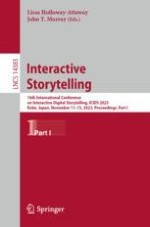This two-volume set LNCS 14383 and LNCS 14384 constitutes the refereed proceedings of the 16th International Conference on Interactive Digital Storytelling, ICIDS 2023, held in Kobe, Japan, during November 11–15, 2023.
The 30 full papers presented in this book together with 11 short papers were carefully reviewed and selected from 101 submissions. Additionally, the proceedings includes 22 Late Breaking Works.
The papers focus on topics such as: theory, history and foundations; social and cultural contexts; tools and systems; interactive narrative design; virtual worlds, performance, games and play; applications and case studies; and late breaking works.
